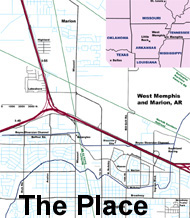
 |
 |
 |
 |
 |
 |
 |
| Summary
of DNA evidence. On July 7, 2004, Bode Laboratories of Springfield, Virginia received evidence items for DNA testing. These items were numbered in a series "2S04-114" from 01 to 36. Although 36 items are listed, many of these represented multiple samples. In the extreme case, 26 hairs found on Chris Byers comprised item #11 and were identified as 11A to 11Z. Samples included:
Forty of the above items and subitems were sent for STR (nuclear DNA) testing as were the reference samples. Samples from swabs were divided into sperm fraction and non-sperm fraction before PCR analysis. This does definitively identify sperm as a source for the sample results, but can clarify trace sperm material separate from victim DNA if sperm is present. Results from the STR analyses: Significant samples with no results or no reportable STR results.
The STR (nuclear DNA) attempted to amplify either 13 or 14 sites and determined sex. Because of the number of reactions and the age of the samples, the only samples that amplified at all sites were those with larger quantities of source material. Specifically, most of the swabs from the victims (oral, penile, rectal and nasal) had complete amplification. For each victim at these sites, the nuclear DNA was their own. The "red-brown stained string" from Stevie Branch also had complete amplification and the DNA matched his own. Partial STR (4 or more sites) amplifications were achieved from other evidence samples. These are sufficient to exclude other sources and indicate whether the DNA was consistent with the reference DNA. Several of the swabs and their fractions fell into this category. In each case, the DNA belonged to the victim. The three hairs (of the collection of 26) that were found on Chris Byers were consistent with Chris Byers DNA. The right hand nail scrapings from Chris Byers were also consistent with his DNA (6 out of 6 site matches). Stevie Branch's ligatures matched at five sites with Stevie Branch's DNA and had a single additional band (described below). Partial STR (less than 4 reportable sites) was achieved from several of the swabs, two fingernail scrapings and the ligatures. These were consistent with the victims with additional bands being found in the sperm fraction of Stevie Branch's penile swab, in the combined left and right nail scrapings of Michael Moore (described as possibly below detection limit), and the nonsperm fraction of the penile swab from Michael Moore. Finding #2. None of the DNA profiles were consistent with those imprisoned. The STR was only able to resolve at multiple sites for a limited number of samples, but none of these were consistent with those in prison, beyond genes that matched the victims. The results were more profound for the mitochondrial DNA where complete resolution took place in 26 of 29 samples - none of which corresponded to those in prison (nor did the two with partial resolution). Finding #3. Several samples had "mixed results." The following evidence samples produced DNA from more than one source. In each case, one source was consistent with being the victim, with an additional band or bands being from another source. The fact that these were few bands suggests presence at the lower limit of detection. The presence of additional bands from Moore's and Branch's penis is suggestive of perpetrator contact with the penis. The additional band in Moore's fingernails may be related to the killer as he had the clearest defensive wounds. Being a single locus in each case, it is inadequate to use to determine with confidence a specific source and in all but one case these bands could have come from sample contamination between victims. For example, transfer of a small amount of blood between victims as they were taken from the water. Alternatively, they could have come from the perpetrator. Band 8 (locus D16S539) was not present in any of the other victims or those imprisoned. Two of the mixed results came from penile swabs, suggestive of criminal contact. Mixed results:
Almost all human cell types have hundreds of copies of mitochondrial DNA (mtDNA). This allows mDNA to achieve test results when nuclear DNA tests fail. Hair shafts only have mtDNA, no nuclear DNA. Twenty-nine of the above items, all hairs, were tested for mtDNA as were the reference samples. Two samples had partial results. One sample 20A (one of the hairs from the blue pants) did not have a reportable sequence. The other 26 had full mtDNA results. Samples 03B (one hair from Michael Moore ligature) and 21A (hair from scout cap) were consistent with the mtDNA of Michael Moore. Samples 08A, 08Ba, and 08Bb, three hairs found on Stevie Branch, were consistent with the mtDNA of Stevie Branch. Samples 11B, 11C, 11P, 11Q, 11V, 11Z (six of a set of 26 hairs found on Chris Byers), 14 (hair from lower body of Chris Byers), 17 (partial sequence, hair from perineum of Chris Byers), 18B, 18C, 18D, 18E, 18F, 18H, 18I (7 hairs from morgue sheet) and 20B (hair from blue pants) are consistent with the mtDNA of Chris Byers. The following samples each had different individual profiles, not matching the victims or those in prison:
Item 15, a hair from Chris Byers ligature, was successfully sequenced but a match has not been found (or named). The origin of the dyed hair, the Negroid hair, and an additional hair from the Cub Scout cap are also undetermined. Two items which failed STR analysis can still be examined by mtDNA. These are the hair/tissue from Stevie Branch's ligature (#09) and the cutting from the blue pants (#25). Serological Research Institute. Fourteen items have been received and processed at the Serological Research Institute (SERI), Richmond, California, as of October 2007. The identities and results from items 1 through 7 are not presented in the appeal documents. Items 8 through 14 were cigarette butts gathered from the home of Terry Hobbs, a Q-tip from Terry Hobbs, cigarette butts from David Jacoby, and hair and a cheek swab from David Jacoby. The cigarette butts from the front yard and ashtray of Terry Hobbs provided a mtDNA profile. There was one nucleotide difference between the hair in the ligature (#03Aa) and the mtDNA profile of Terry Hobbs. Similarly, the cigarette butts and cheek swab from David Jacoby displayed one nucleotide difference between the hair at the tree stump. This can also be due to a natural variation in mtDNA within a person. In each case there was a single nucleotide discrepancy, described in more detail below. The limits of the matching of the mtDNA are discussed elsewhere. The swab from Terry Hobbs and the cigarette butts from his driveway were not successfully clarified. The hair from Jacoby was saved for possible future testing. Summary. The DNA results so far are tantalizing. The hair from Michael Moore's binding is consistent with Terry Hobbs being the source. The hair from the stump is also consistent with David Jacoby being the source. Jacoby has stated he was not in this area during the search. Both of these sequences have at least one nucleotide difference from their respective matched samples - explainable by heteroplasmy and diminishing the statistical power of the conclusions. The source of several hairs can provide additional answers, particularly matching the successfully amplified DNA found beneath Chris Byers ligature. Nowhere has it been mentioned in the appeals documents that DNA has been tested for any other prime suspects. The samples of DNA from Terry Hobbs were surreptitiously obtained. A formal and larger sample could bring clearer results. Items not tested by STR or mtDNA.
|
![]()
|
Copyright © 2008 Martin David Hill
|
|
Site Design By Michael Gillen
|